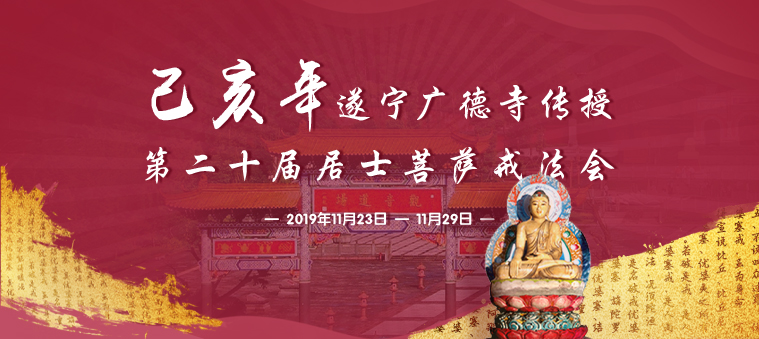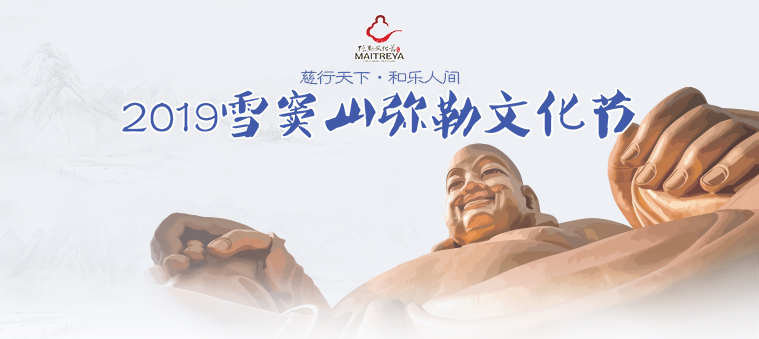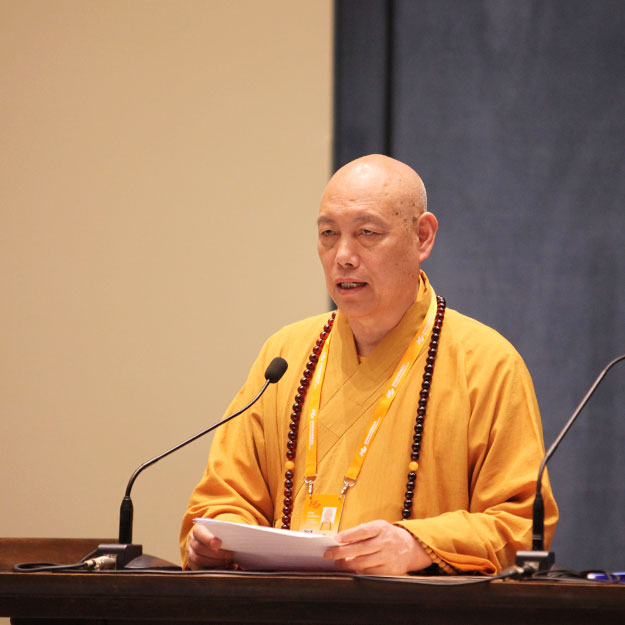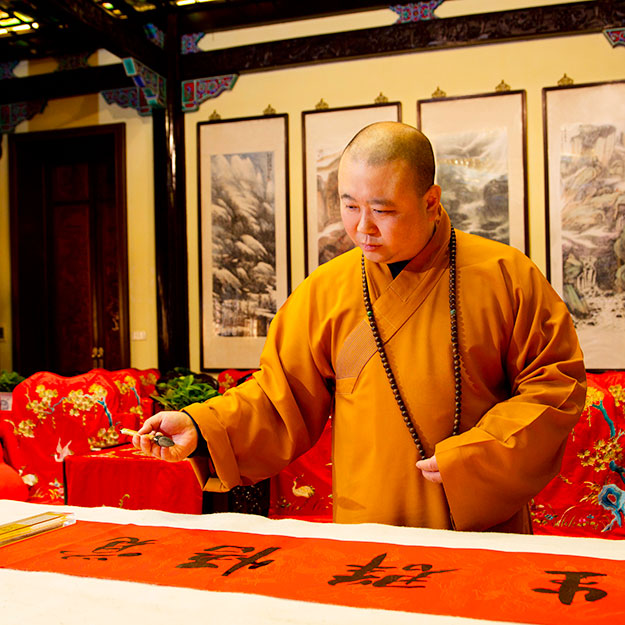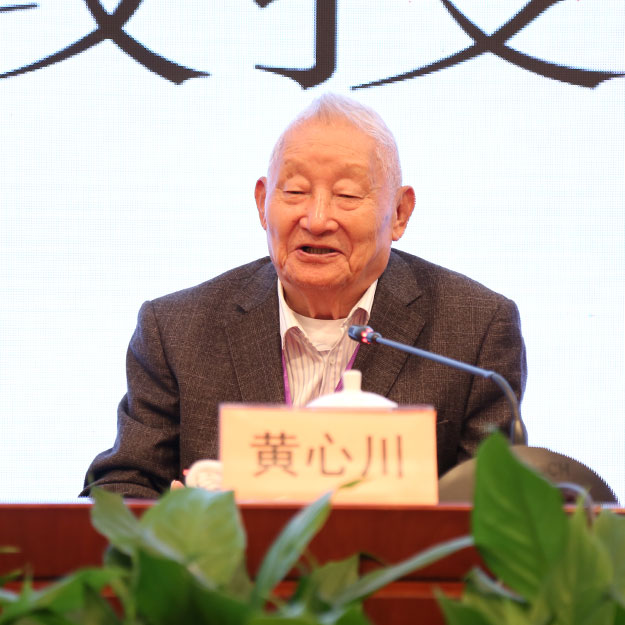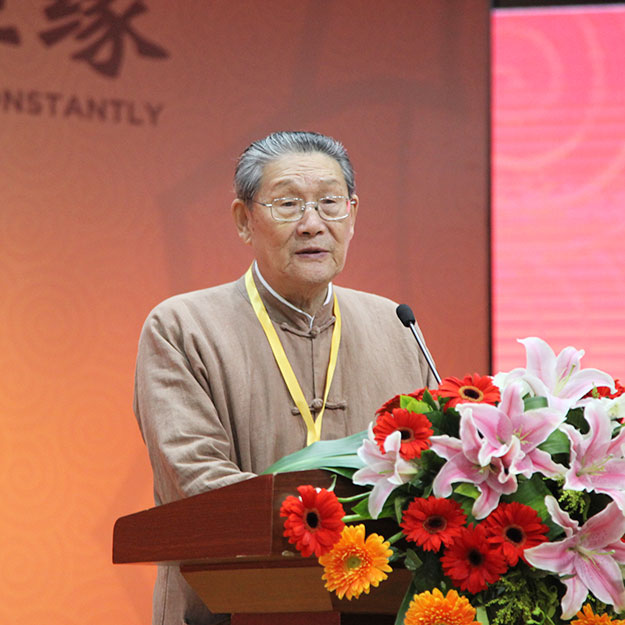觉醒法师--充分发挥佛教作为文化形态的济世导俗的功能
来源:菩萨在线 发布者:妙言 时间:2012-04-28
觉醒大和尚精彩演讲(图片来源:菩萨在线 摄影:心毅)

觉醒大和尚精彩演讲(图片来源:菩萨在线 摄影:果信)
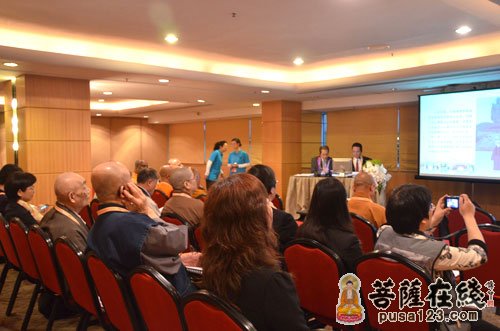
论坛专题讨论会现场(图片来源:菩萨在线 摄影:心慈)
菩萨在线香港讯 2012年4月26日上午8时30分,第三届世界佛教论坛开幕式在香港红磡体育馆隆重举行,此次论坛为期2天,论坛期间,与会代表围绕“和谐世界,同愿同行”的主题,举行七场分论坛、六场电视论坛和一场网络论坛。其中,七场分论坛备受关注,来自海内外的高僧大德围绕“佛教弘法的现代模式”、“佛教文化的继承与弘扬”等主题发表了演讲。
以下是中国佛教协会副会长、上海市佛教协会会长觉醒大和尚的发言及英文翻译全文:
佛教由上至皇宫贵胄、下至黎民百姓之辈的基本信仰的角度出发,其作为宗教在中国社会各阶层的精神慰藉方面,及推动中华文明根深叶茂之中,所发挥功能是显而易见的。同时,佛教作为文化,对丰富中国传统文化的贡献,以及在继承和发扬中国传统文化、推动当下文化大发展、建设文化强国中的作用,同样需要在当今时代予以格外的关注,需要特别的予以发掘并取得共识,只有如此,才能充分发挥佛教作为文化形态的济世导俗的功能。
一、宗教、佛教、文化的三大概念的理解和相互关系
中国佛教界的前贤,包括赵朴初居士、太虚大师、印顺导师等在内的各位大德,都对佛教既是宗教又是文化,有着诸多精辟的见解。其中,宗教与文化的功能,构成了佛教的两大内涵。何谓宗教?虽然这是一个难有定论的问题,但确实是一个十分很重要的问题,在此不想做深入详尽的展开。但其作为人们的精神慰藉与终极关怀的功能,当是其最为重要的特征,也是人们对宗教的基本共识。而文化,就我本人的窥豹之见,是对人们物质生产活动和精神创作活动的过程及其结果概括和描述。文化是一种动态的、现实中的活动过程,而文明则是这种过程的凝固态的叙述、历史性的追述。由此可见,在佛陀创立佛教之後的两千五百多年的历史长河之中,佛教确实承担着作为人们精神慰藉与终极关怀的宗教功能,又肩负着引导人们物质生产活动及绽放精神创作活动、繁盛人类精神之林的职责。从这个意义上说,佛教是宗教,也是文化。佛教通过其宗教活动,凸显着抚慰安顿人类心灵的强大机制;佛教通过其文化活动,彰显着济世导俗社会良知的卓绝功能;丧失宗教功能,佛教就无从谈及精神慰藉与终极关怀,缺失文化功能,佛教就无法发挥济世导俗与精神引领。总之,离开了宗教和文化,佛教的个体担当与社会人类社会发展的历史,首先是物质生产活动,继踵而至的是精神生活的日益丰富和复杂,由此,导致了人类文明历史的演绎。由此,更高层次的精神索求,是人类文明的基本特征。精神的索求之最典型的模式,即为宗教。宗教是人类早期精神活动的产物,也是人类最具生命力的精神家园。英国著名历史学家汤因比在其研究人类社会文明形态的过程中,深刻揭示了宗教作为文明生机之源泉的重要历史地位,而文明形态本身即是文明所固有的宗教信仰形态的反映和体现。由此可见,宗教与文化是人类文明形成的核心要素。由此,作为中华文明之重要构成的佛教,对于中华文化的繁荣,应当作出自身的贡献,对当前正在如火如荼开展着的文化大发展理当有积极的回应。
回顾历史,自东汉初年佛教传入中国後,来自印度的佛教文化,为古老而博大精深的中华文明,注入了新的活力,西域诸国及中华本土的僧人积极翻译经典、四处讲学、阐释义理,极大丰富了中华文明的精神内涵。经过自东汉以至魏晋南北朝时期的充分吸收和积淀,至隋唐盛世,本土化的中国佛教宗派,在诸多祖师大德的努力下,深深扎根於中华文化深厚的土壤之中。本土化的中国佛教,在祭祀仪规、佛教节日、思想体系架构中,融汇了中华文化的诸多元素,特别是与民族风俗、民族思维模式密切适应;同时,佛教经典的汇集方式、语言学的四声发音法、特别是其精深的哲学思维风格、缜密的逻辑推理模式、对人生、自然、心理独特的分析视角,以及卓有成效的心理调适方法等等,推动了儒家文化、道家文化的吐故纳新,新陈代谢,宋代以后儒家学说中理学及相继而生的心学等,道教的经典汇集《道藏》的问世,都无不渗透着佛教文化的深刻影响。无论是在中国的文学艺术、建筑风格、哲学思辨,还是人生理念等诸方面,佛教文化的熏染是随处可见的,佛教已经成为中国传统文化中不可分割的重要组成部分,是中华文明儒释道三大精神资源中不可或缺的一项。
由此,作为宗教和文化的佛教,在中华文明进程中的具体功效,不仅表现在其作为精神慰藉与终极索求等宗教情感上,为社会民众提供了一种全新信仰体验;同时,表现在作为文化的佛教,又在具体的文学创作意境、艺术表现手法、思想体系建构、民族风俗内涵等诸多领域,与中国传统的思想文化相结合,形成思想意境和表现手法独特的文化奇葩,深深地影响着中国民众的思想与生活。数千卷由梵文翻译过来的佛教典籍,本身就是伟大而珍贵的文学作品,为中国传统文学带来了意境、文体、遣词方法等方面的全新气象;《法华经》、《维摩经》、《百喻经》等经典鼓舞了晋唐小说以及後来戏剧、连环画小人书的创作;般若和禅宗思想,对丰富魏晋以降以至于唐诗宋词元曲等创作的意境的影响,是特别显著的;而陶渊明、王维、白居易、苏轼等诸多文人的诗词赋创作中,处处可见佛教在文学家心灵中挥之不去的印象。变文、俗讲和禅师的语录等佛教通俗文学表现手段,又都与中国民俗文学有着难以割舍的渊源。在书法绘画方面,佛经中的动人故事,常常成为艺术家创作的源泉,曹不兴、顾恺之、张僧繇、展子虔、阎立本、吴道子、乃至於清初四大画家石涛、八大山人等,历代名家皆以擅长佛画而著名;中国画学中由王维一派的文人画而发展到宋元以後盛行的写意画,则与禅宗思想有关。在音乐方面,公元三世纪,因曹植于渔山创作,我国已有佛教梵呗的流行;唐代音乐又吸收了天竺乐、龟兹乐、安国乐等来自佛教国家和地区的音乐,唐乐至今还有少部分保存在某些佛教寺庙的唱诵中。在建筑方面,我国古代建筑保存最多的是佛教寺塔,许多佛教建筑已成为我国各地风景名胜区的突出标志;我们所在的灵山梵宫,即是当代佛教建筑艺术的杰作。精巧的佛教建筑为祖国锦绣江山平添了无限光彩。以上所举,仅是两千年来中国佛教文化艺术之一斑。
由此可见,佛教不仅丰富了中国传统文化艺术的创作题材和表现手法,而且升华了其中的哲学意境和思想内涵,在中国历史上留下了辉煌灿烂的文化遗产。另一方面,也正是通过诸多的文化艺术表现形式,拉近了佛教与社会大众的距离,佛教的思想、义理与信仰生活更加容易为社会所接受。
二、佛教文化在当代所发挥的济世导俗作用
及至当下,中国已经成为对国际事务拥有深刻影响力的大国,无论就国土面积、经济总量和人口总量,中国成为当今世界负责任的大国,已经是保障世界和平、促进世界和谐稳定的重要因素。而要推动中国真正成为国际社会中能够担当的成员,不仅取决於我们的经济总量,更重要的是能否成为文化强国,将中国传统文化发扬光大,影响和推动世界的和谐,切实减缓和化解人类社会所面临的信仰危机、道德滑坡、精神空虚等诸多现代综合症。就佛教文化而言,发挥其在当代社会中济世导俗的作用,是我们弘扬佛教信仰,发扬佛教文化的主旨。就当前中国政府倡导和注重建设文化强国之际,佛教有可以有所作为,也必定能有所作为的。其理由如下:
1、随着我国改革开放与经济发展,我国三大语系佛教文化也得到了前所未有的发展,可以说是中国佛教文化繁荣发展的黄金时期。各级佛教组织十分重视佛教文化建设,刊印佛经,发行定期和不定期的各类佛教杂志百余种,举办不同形式的佛教文化学术研讨会、佛教书画展、佛乐演出等,不仅弘扬了佛教的优秀文化,也为净化人心,促进和谐社会的建设发挥了积极作用。
2、改革开放三十多年来,佛教文化蓬勃发展,为我国佛教文化海外交流,提供了良好的基础;在政府主管部门的指导下,按照中国佛教协会的统一部署,中国佛教协会及各省市佛教协会,曾多次赴海外举办内容丰富充实的佛教书画展,各地梵乐团将隽永天籁般的佛乐带到了欧美和东南亚诸国,在国际“卫赛节”、以及中韩日三国佛教友好交流会议上的佛乐汇演,均受到广泛赞誉,为繁荣我国多元文化,增进相互了解与友谊,发挥了不可替代的作用。
3、在我国主办的前两届“世界佛教论坛”期间,与会海外代表不仅领略了我国佛教寺院建筑艺术的魅力,感受了大型佛教和平祈祷法会的心灵启迪,而且分别在上海和无锡举行的大型佛乐演出,更受到海内外信众的广泛赞誉。这些佛教文化活动的举办,为宣传我国改革开放与和平发展、宗教信仰自由政策、佛教慈悲济世的和谐理念,为扩大我国的对外影响,宣传我国和平发展的外交路线,做出了积极贡献。
当然,我们要真正将佛教文化济世导俗的作用充分发挥,并在社会中产生积极的、可以感知的效果,中国佛教界必须注重自身的建设。从具体的举措上而言,应该在今后更加在以下四个方面,有所建树,有所强化:
1、佛教文化艺术的发展,离不开人才的培养,佛教文化艺术的人才培养,是提升我国佛教文化艺术发展品位的重要保障。因此,各级佛教组织与佛学院应重视佛教文化艺术人才的培养;同时要结合我国佛教三大语系的文化与艺术特点(如佛教造像、书法、绘画、乐舞、唐卡绘画与酥油花制作、贝叶经雕刻等艺术),要不断发掘佛教文化艺术人才,拓展人才培养渠道,完善人才培养的长效机制,为我国佛教文化建设与艺术发展,培养更多弘法利生、爱国爱教的文化艺术人才做出贡献。
2、随着国家的改革开放,经济发展,宗教信仰自由政策的贯彻落实,当前是中国佛教文化发展的黄金时期,各级佛教组织应在中国佛教协会的统一领导下,重视佛教非物质文化遗产的继承与保护,进一步发掘和整合国内佛教文化艺术资源,发挥我国佛教三大语系的文化艺术优势,通过繁荣和发展佛教文化艺术,为弘扬佛陀的和平理念,引导佛教信众正信、正行,净化人心,促进社会和谐,发挥积极作用。
3、中国大陆与香港、澳门、台湾的同胞,可谓同宗同源,佛教信仰法乳一脉,佛教文化艺术建设模式不同,但却异曲同工,都是弘扬佛教的优秀文化艺术,有利于净化人心,和谐社会。应按照中国佛教协会的统一部署,在各级政府的指导下,进一步加强与香港、澳门、台湾佛教界之间的友好联系与合作,拓展佛教文化艺术交流的渠道,并通过佛教文化艺术这一弘法形式,增进相互了解,巩固血脉亲情与法源同宗之谊。
4、佛教文化艺术,历来是我们弘法利生的重要途径,文化品类纷呈,艺术表现形式多彩。如佛经刊印与流通、佛教杂志发行、佛教文化艺术研讨、佛经念诵、佛教仪式与法会、佛教书画展示、梵乐演出、佛教造像、佛教艺术品等。各级佛教组织在佛教文化建设方面做了大量工作,成绩显著,受到社会各界的广泛赞誉。佛教文化艺术建设也要随着时代的进步和社会的发展,与时俱进。我们应认真总结以往在文化艺术建设方面积累的丰富经验,依托我国佛教三大语系齐备、汉传佛教八大宗派共兴的优势,本着求同存异、开拓进取的精神,展现无缘大慈、同体大悲胸襟;本着立足众缘和合、适应社会的原则,进一步整合我国佛教文化艺术资源,找准佛教文化艺术在盛世环境之中的定位和角色,为进一步繁荣佛教文化艺术,服务于经济社会建设,服务于贯彻落实科学发展观,服务于国家和平发展大局,在中国佛教协会的领导下,调动各级佛协组织的积极性,结合目前佛教文化艺术建设的特点,适时契机地开展形式多样、丰富多彩的佛教文化艺术活动、学术研讨,促进佛教文化艺术、学术研究的进一步繁荣和发展。
综上所述,我们已经进入了人类历史上世纪大转折时期,世界的和平、经济的发展、环境的保护、多极化的世界、多极化的文化,既是机遇,也是挑战和压力,我们在倡导和发扬佛教文化的过程中,必须注意文化内涵的融合与艺术形式的兼容。这其中不仅包含了云南南传上座部佛教、承袭印度大乘佛教而来的汉传佛教、与承袭印度密教而来并吸纳本教的藏传佛教的三大语系佛教内部的融合,还包含了不同宗教、不同民族、不同地域文化艺术的融合。因此,我们有必要,有责任,在圆融无碍、交流协作的前提下,以百花齐放、争相竞发的姿态,为中国佛教文化的繁荣,营造良好的氛围、为文化和谐开创局面。
觉醒
英文翻译稿如下:
It is obviously to find the function of Buddhism in basic belief of emperors, kings, nobles and the average people, and in the aspect of spiritual comfort of the classes in the society as a religion, and in the promotion of bloom of Chinese civilization. At the same time, as culture Buddhism's contributions of enriching Chinese traditional culture and role played in inheriting and promoting Chinese traditional culture, in promoting the vigorous development of culture in these days, and in the building of the powerful cultural country, are needed to pay particular attention in our times and in particular to be tapped and reached the consensus on them, and only in this way can we take full advantage of the function of benefiting the world and guiding the people of Buddhism in cultural form.
1. Comprehension and Interrelations of the Three Concepts of Religion, Buddhism and Culture
Former sages of Chinese Buddhist community including lay Buddhist Zhao Puchu, Master Taixu, and Mentor Yinshun possessed many illuminating views on that Buddhism is both a religion and culture. Especially, the two great conceptions of Buddhism are constituted by the religious and Cultural functions. What is religion? This is an open question which is difficult to give a single answer, but indeed is a vital question, and I do not want to discuss it in details in this article. However, it has the function of spiritual comfort and Ultimate Concern for people which is its most important characteristic and is the public basic agreement on religion. Culture, based on my glimpse of the truth, is the generalization and description of the process and the results of people's activities in the material production and the Spiritual creation. Culture is a dynamic and realistic course of activities, while civilization is the solidified narrative of this course and a historic recount of it. From the above, in the long history of two thousand five hundred years after Buddha founded Buddhism, Buddhism really assumes the religious function which provides the spiritual comfort and Ultimate Concern for the people, and shoulders the responsibility to multiply spirit forest of human by guiding people's activities in the material production and bloom of Spirit creation. In this sense, Buddhism is both a religion and culture.
By its religious activities, Buddhism highlights powerful mechanism of soothing and calming down the human mind; and by its cultural activities, Buddhism demonstrates the extraordinary function of benefiting the world, guiding the people and Social conscience; without its religious function, it is impossible to talk about spiritual comfort and Ultimate Concern of Buddhism, and without cultural functions, Buddhism can not be made use of the advantage of benefiting the world, guiding the people and Spiritual leading. In short, without religion and culture, either inpidual or social responsibility of Buddhism exists.
The history of human social development, first of all, is the activity in material production followed by increasingly richness and complication of means of Spiritual living, from this, as a result, the history of human civilization is expanded. From the above, a higher level of spiritual demand is the principal feature of human civilization. The most typical model of Spiritual demand is religion. Religion is a product of the early Spirit activities of human beings, and is also the Spiritual Home which has a potentially wide application for human beings. Mr. Toynbee, the famous British historian, in the process of his study on forms of civilizations of human society, deep uncovered that the important historical position of religion as a vitality source of civilization, and that the form of civilization itself is the reflection and exhibition of religious belief which is inherent in the civilization. Obviously, religion and culture are the core elements of human civilization. Hence, Buddhism as an important component of the Chinese civilization, should make its own contributions to the prosperity of Chinese culture, and should have a positive response to the vigorous development of the culture which is currently undertook in full swing.
A review of the history will show, since the Eastern Han Dynasty when Buddhism was introduced to China, Buddhist Culture from India injected fresh vitality into ancient and profound Chinese civilization, and monks from countries in Central Asia and China who actively translated scriptures, gave lectures around and explained doctrines, overwhelmingly enriched the Spiritual connotation of Chinese civilization. After full absorption and accumulation from the Eastern Han Dynasty, Wei Dynasty, Jin Dynasty as well as Southern and Northern Dynasties, in dynasties of Sui and Tang, the localized Chinese Buddhist sects, with the efforts of many Masters and great men, had been deeply rooted in the profound soil of Chinese culture. In Buddhist worship rituals, Buddhist festivals and architecture of thinking system, localized Chinese Buddhism integrated many elements of Chinese culture, and is especially closely adapt with the national customs and national mode of thinking; at the same time, the method of compilation of Buddhist classics, linguistics pronunciation rules of four tones, especially its extensive philosophical thinking style, meticulous logical mode of reasoning, the unique perspective of analysis of life, natural and psychology, and successful methods of mental adjustment and others promote the change of Confucian culture, Taoist culture, and the Confucian School of Principles and the successive School of Mind in and after Song Dynasty, the assembly of Taoist classics Collected Taoist Scriptures, are all profoundly penetrated by the influence of Buddhist Culture. Whether in the Chinese literature and arts, in architectural style, in philosophical analysis, or in life philosophy and other aspects, the influence of Buddhist Culture can be found everywhere, and Buddhism has already been an important integral part of Chinese traditional culture, and is an essential one among three Spiritual resources of Chinese civilization, i.e., Confucianism, Buddhism, and Taoism.
Therefore, in the process of Chinese civilization, specific functions of Buddhism as a religion and culture are not only religious emotions of spiritual comfort and Ultimate Concern which provided a totally new belief experience for the people in the society; but also, as Culture, combining with the traditional Chinese culture in such fields as the specific artistic conception of the literary creation, the means of expression of arts, the construction of the thinking system, and the connotation of national customs, formed precious cultural flowers with unique means of expression and thoughts, profoundly influence the thoughts and life of the Chinese people. Thousands of volumes of Buddhist classics translated from Sanskrit, which themselves are great and precious literary works, brought new things such as artistic conception, literary style and diction methods to traditional Chinese literature; the Lotus Flowers Sutra, the Vimalakirti Sutra, and the Sutra of One Hundred Fables and other classics inspired the creations of the fictions in dynasties of Jin and Tang and plays, comic strips later; thoughts of Prajna and Chan are particularly notable in influence of enriching the artistic conception of Tang Poems, Song Iambic Verses and Yuan Songs after dynasties of Wei and Jin; Buddhist impressions which can not be erased in the scholars' mind can be found everywhere in creations of poems and verses of these scholars such as Mr. Tao Yuanming, Mr. Wang Wei, Mr. Bai Juyi, and Mr. Su Shi. The simple and easy understanding means of expression of Buddhist literature such as stories, lectures and the quotations of Chan Masters shares the same origin which is hard to break away from the Chinese folk literature. In calligraphy and paintings, the moving stories in Buddhist sutras often become the source of creation of artists, Mr. Cao Buxing, Mr. Gu Kaizhi, Mr. Zhang Sengyou, Mr. Zhan Ziqian, Mr. Yan Liben, Mr. Wu Daozi, even four painters Mr. Shi Tao, Mr. Bada Shanren, etc. in the early Qing Dynasty, all these ancient famous artists were famous because of being good at Buddhist paintings; that Chinese Painting developed from the school of Literati Painting led by Mr. Wang Wei to Impressionist Painting which is prevalent in and after the Song and Yuan dynasties has closed connection with Chan thoughts. In music, when Mr. Cao Zhi composed poems in Yushan in the third century, Buddhist music was already popular in China; music of Tang Dynasty absorbed the music of Buddhist countries and regions such as India, Qiuci and Anguo, till now there is a small part of music of Tang Dynasty remained in chants of some Buddhist temples. In architecture, most ancient architectures in China which remains till now are pagodas of the Buddhist monasteries, and many Buddhist buildings have become prominent signs of scenic spots in different places of our country; Lingshan Buddhist Palace where we stayed now is a masterpiece of contemporary architectural art of Buddhism. Delicate constructions of Buddhism added infinite glory to the beautiful land of our motherland.
Which are amplified above only give some ideas of literature and arts of Chinese Buddhism over the past two thousand years. From the above, Buddhism not only enriches the themes and methods of expression of creation of the Chinese traditional literature and arts, but also sublimates philosophical conceptions and connotations of thoughts and left a brilliant cultural heritage in Chinese history. On the one hand, by many forms of expression of literature and arts it shortens the distance between Buddhism and the people in the society, the principles, belief, thoughts of Buddhism were much more easily accepted by the society.
2. Buddhist Culture in the Contemporary Era Plays the Role of Benefiting the World and Guiding the People
Until the present days, China has already become a powerful country which has profoundly influence on international affairs, whether in land area, in total economic output or in the total population, China has become a responsible powerful country in today's world and is already an important factor for safeguarding world peace and promoting world harmony and stability. To promote truly China to become a member which can play a responsible role in the international community, not only depends on our total economic output, but also more importantly on that China can become a powerful cultural country, and on we constantly carry forward the Chinese traditional culture with great impact and impetus to the harmony of the world, and effectively to mitigate and resolve modern Syndromes which are faced by human society such as the crisis of belief, moral decline and spiritual emptiness. For Buddhist Culture, it is the subject of spreading Buddhist belief and promoting Buddhist Culture to make use of its role of benefiting the world and guiding the people in contemporary society. In these days when current Chinese government advocates and concerns the building of the powerful cultural country, Buddhism can play its role and certainly can. The reasons are listed below:
A. Along with reform, opening and economic development in China, Chinese Buddhist Culture of three major languages has also been developed unprecedentedly, in this sense we may say that this period is the golden era of prosperity and development of Chinese Buddhist Culture. Buddhism organizations at all levels very highly concern the building of the Buddhist Culture, publication of Buddhist Sutras, issue of hundreds of kinds of regular and irregular Buddhism magazines, organizing different forms of the academic seminars about Buddhist Culture, exhibitions of Buddhist Calligraphy and Paintings, Buddhist music performances, not only spread the outstanding Buddhist Culture, but also played positive roles for purifying people's minds and promoting the construction of Harmonious Society.
B. In this period of more than thirty years since the policy of reform and opening was introduced, the bloom of Buddhist Culture provides a proper basis for overseas exchange of Chinese Buddhist Culture, under the guidance of the departments of government in charge of this work, according to unified dispositions of China Buddhist Association, China Buddhist Association and Buddhist Associations of provinces and municipalities organized abroad for many times Buddhist Exhibitions of Calligraphy and Paintings which were rich in content, and Buddhist Music Bands from different places brought timeless Buddhist music which sounds like heaven music to countries in Europe, America and Southeast Asia, and Buddhist music shows on the international Vesak Day and on the Friendly Exchange Conference of Buddhism of China, Korea and Japan, and they won broad admiration and play the irreplaceable role for the prosperity of China's multi-culture and promoting understanding and friendship among one another.
C. During the previous two World Buddhist Forums which were hosted in our country, the participating overseas delegates felt the charm of the architectural art of Buddhist temples in China, and also tasted spiritual enlightenment in large Buddhist Dharma Assemblies for peace prayers, furthermore, the large scale Buddhist Music Performances which were held in Shanghai and Wuxi were widely praised by believers at home and abroad. These Buddhist cultural activities made positive contributions to announce the China's policies of reform and opening, peaceful development and freedom of religious belief, and the Buddhist concept of harmony of the Compassion, Mercy and benefiting the people, and to extend our country influence abroad, and to announce our country's diplomatic line of peaceful development.
Of course, if we really want Buddhist Culture take full advantage of the role of benefiting the world and guiding the people and produce positive effects in society which can be perceived, Chinese Buddhist Community must concern their own construction. More specific acts should be done in accomplishing and strengthening the following four areas in the future
1. The development of Buddhist literature and arts can not be separated from the training of personnel, and the training of personnel of Buddhist literature and arts is an important guarantee to enhance the developmental level of Buddhist literature and arts in China. Thereupon, Buddhist organizations and the Buddhist Colleges at all levels should pay serious attentions to the training of personnel of Buddhist literature and arts; at the same time, to combine the literary and artistic characteristics of Chinese Buddhism of three major languages (such as Buddhism statues, Calligraphy, paintings, music and dance, Thangka paintings and butter sculpture, sculptures of Pattra Sutras and others), and we should constantly tap the talents of Buddhist literature and arts, expand training channels of personnel, improve the long-term regime of training of personnel, and for the building and development of Chinese Buddhist literature and arts, make contributions for training more talents of literature and arts who love the country and love Buddhism for spreading of Dharma and benefiting all sentient beings.
2. In the process of reform, opening and economic development of our country and implementation of the policy on freedom of religious belief, the present period is a golden era for the development of Chinese Buddhist Culture, Buddhist organizations at all levels under the unified leadership of China Buddhist Association should highly concern the protection and inheritance of intangible cultural heritage of Buddhism, further tap and integrate the resources of domestic literature and arts of Buddhism, make use of advantages of literature and arts of Chinese Buddhism of three major languages, and through prosperity and development of Buddhist literature and arts, should play a positive role to promote the Buddha's idea of peace, to guide right faiths and right behaviors of Buddhist believers, to purify people's minds, and to promote social harmony.
3. The compatriots from China mainland, Hong Kong, Macao and Taiwan, can be said that they belong to the same clan and the origin and that their beliefs of Buddhism share the same Dharma origin, although the construction modes of Buddhist literature and arts are different, have the same effects and are the excellent literature and arts to promote Buddhism, and are good for purifying people's minds and harmonious society. According to the unified disposition of China Buddhist Association, under the guidance of governments at all levels, friendly connection and cooperation with Buddhist Community of Hong Kong, Macao and Taiwan should be further improved, by expanding the exchange channels of Buddhist literature and arts, and by Buddhist literature and arts and forms of spreading Dharma, to enhance mutual understanding and to consolidate blood kinship and friendship of sharing common ancestry and origin.
4. Buddhist literature and arts have always been our important ways of spreading Dharma and benefiting all sentient beings, and its literary categories and forms of artistic expression are multiple and colorful. Such as the publication and circulation of Buddhist Sutras, issue of Buddhist magazines, seminars about Buddhist literature and arts, recitation and chant of Buddhist Sutras, Buddhist ceremonies and Dharma Assemblies, Exhibitions of Buddhist Calligraphy and Paintings, Buddhist music shows, Buddhism statues, products of Buddhist arts and so on. Buddhist organizations at all levels did a great deal of work in the construction of Buddhist Culture and made Significant progress which widely praised by the Public. The construction of Buddhist literature and arts should constantly advance with the times in the progress of the development of times and society. We need to carefully review the rich experience accumulated over the building of literature and arts before, relying on advantages of that Buddhism of three major languages is available in China and the eight major sects of Han Buddhism boom, with the spirit of seeking common grounds and reserving differences, the Spirit of breaking fresh ground and embodied breadth of Visions of the Great Compassion without Conditions and the Great Mercy as One Body; based on the spirit of A Synergy of Conditions and meeting the requirements of society, we further integrate the resources of literature and arts of Chinese Buddhism, seek the position and role of Buddhist literature and arts in the golden era, and in order to further promote prosperity of Buddhist literature and arts, to serve economic and social development, to serve establishing and putting into practice the Scientific Outlook on Development, and to serve the over-all situation of national Peaceful Development, under the leadership of China Buddhist Association, we should arouse the enthusiasm of Buddhism Associations at all levels, combining with characteristics of the current construction of Buddhist literature and arts timely run the delicately fashioned, varied and interesting literary and artistic activities of Buddhism, academic seminars, and further promote prosperity and development of Buddhist literature and arts and academic researches.
To sum up, we have entered a momentous century turning period in the history of mankind, world peace, The growth of economy, environmental protection, World Multi-polarization, Culture Multi-polarization are opportunities and challenges and pressure, and it is necessary to pay attention to the integration of the cultural connotations and the compatibility of artistic forms in the process of that we advocate and promote Buddhist Culture. The integration not only consists of the internal integration of Buddhism of three major languages i.e., the Yunnan Theravada Buddhism, Han Buddhism which developed from Indian Mahayana Buddhism and Tibetan Buddhism which developed from Indian Esoteric Buddhism and absorbed Bon Religion, but also consists of the integration of literature and arts of different religions, different nations and different regions. Therefore, we have the necessity and the responsibility to always bear the aim of exchange and cooperation harmoniously without problems in mind and the attitude of letting hundreds of flowers Blossom and develop together, and to create a favorable environment and a good situation for the prosperity of Chinese Buddhist Culture and cultural harmony.
Juexing
(责任编辑:赵龙龙)




